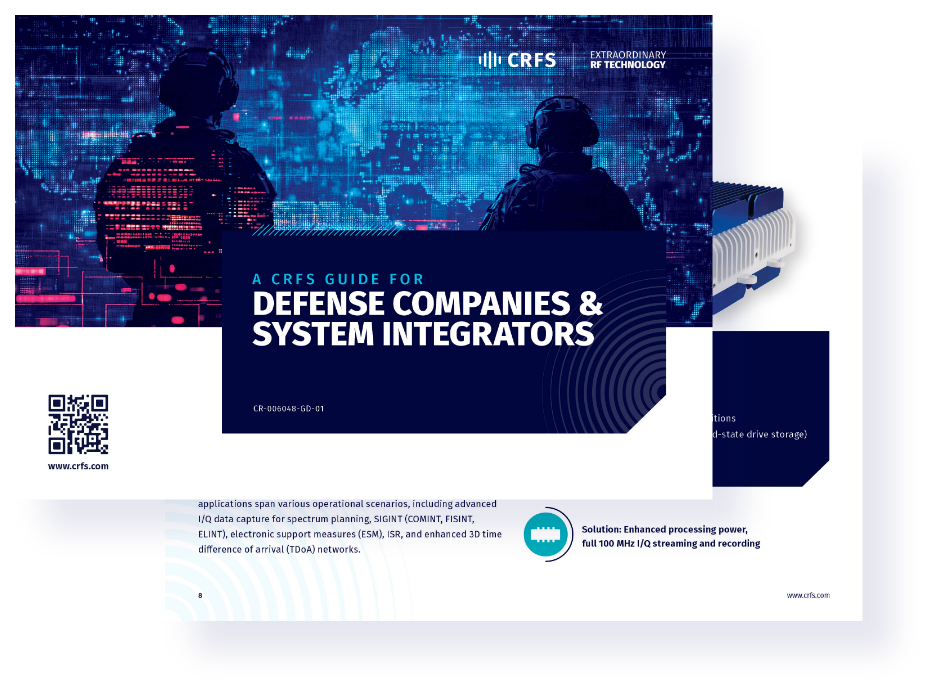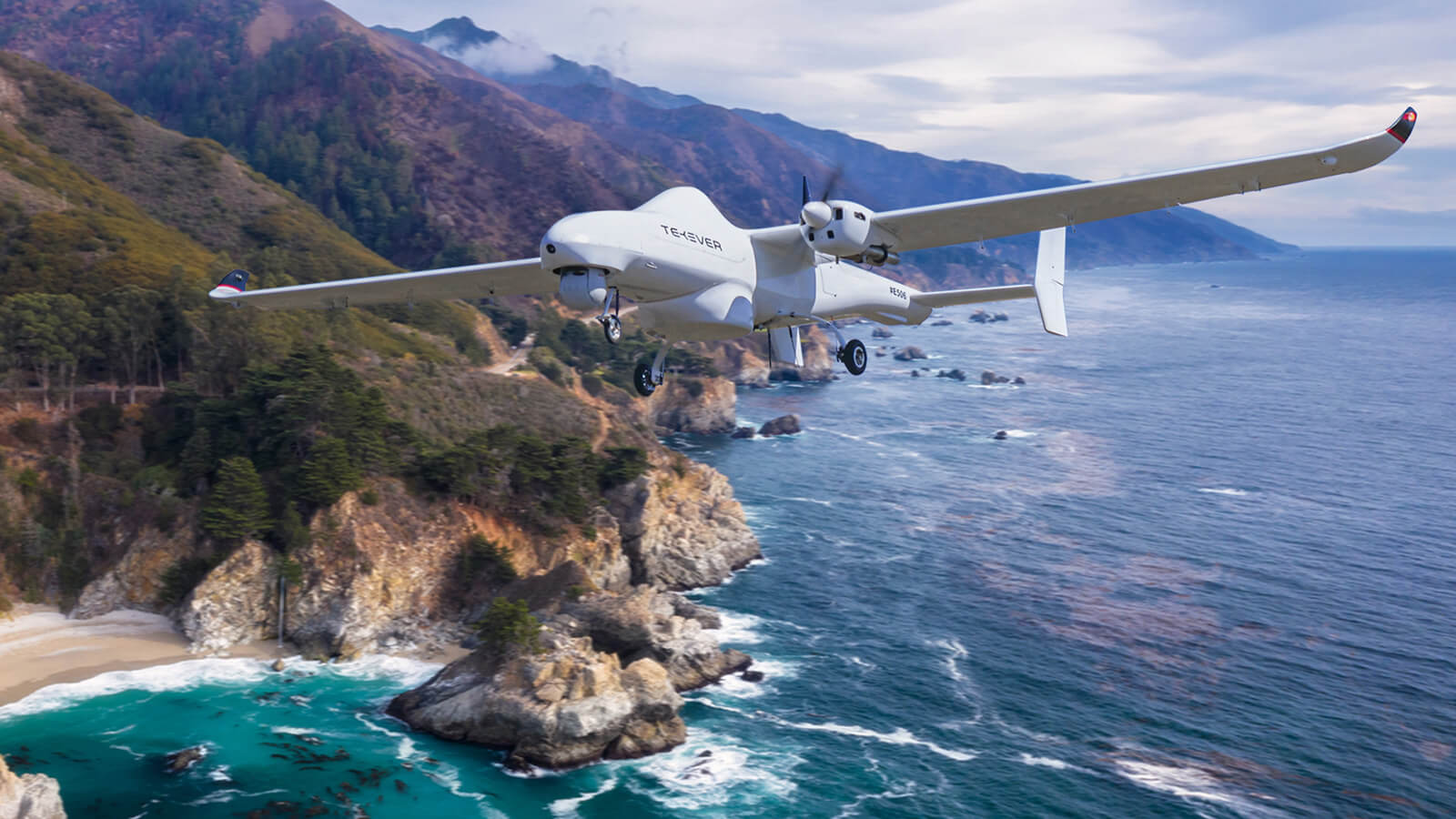Solutions for
Defense companies & system integrators
Advanced COTS RF sensor technology and powerful software seamlessly integrated into system-of-systems for advanced electromagnetic spectrum capabilities.
Overview
In today’s complex operational environments, staying ahead requires tools that deliver near real-time, highly trusted intelligence, not just data. CRFS’ RFeye technology enhances multi-sensor data fusion with early warning signal detection and precise geolocation capabilities, empowering integrators to create smarter, more responsive systems.
CRFS’s advanced capabilities have enhanced our spectrum analytics, increasing value to end users and expanding mission support.
The groundbreaking partnership between TEKEVER and CRFS is a testament to the power of collaboration
CRFS’ TRL-9 technology is deployed globally, delivering proven performance in challenging operating environments. Our hardware is designed for simple, modular integration, and our open APIs ensure seamless integration of RFeye software into system-of-systems—saving time and reducing complexity.
With vast experience partnering with systems integrators of all sizes, CRFS brings a consultative, co-engineering approach to every project. From concept to design, manufacture, and delivery, every step is carried out in Cambridge, UK, ensuring quality and agility. As a non-ITAR supplier, we eliminate export restrictions, making the whole process faster and simpler. And post-delivery, CRFS provides support packages to ensure a smooth integration process.
CRFS Technology
Continuously monitor the spectrum for RF data
- 9kHz to 40GHz wideband monitoring & in-built RF edge processing
- Next-generation SDR technology
- Distinguish & detect signals from the noise floor
Gain insight into large data sets and share actionable RF intelligence
- Signal Discovery to find low probability of intercept and low probability of detect signals
- Smart sweeps, scans, surveys, and incident alerts
- Automated geolocations
- Interoperability enabled by open APIs
- Stream data in real-time in formats such as VITA-49
- Advanced spectrum monitoring and geolocation
Capture and exploit wideband, long-duration I/Q data (RF intelligence) in high-fidelity
- Capture and record I/Q data
- Forensic signals analysis
- Advanced SIGINT
Explore scenarios, RF modeling, and RF simulation
- RF training and simulation
- Wargaming tool
- Geospatial analysis and optimizing sensor networks

Brochures, Guides & Survey's
A CRFS Guide for Defense Companies & System Integrators
CRFS provides sub-systems for defense companies and system integrators requiring RF capabilities in larger systems or platforms. This guide introduces solutions and applications.
Multi domain operations
USV
UGV
UAV
Electronic
warfare systems
Airborne ISR
c-UAS
Maritime
Air defense system

BROCHURE
APIs
CRFS sensors (RFeye Nodes) are interchangeable across platforms and supported by open APIs to allow third party systems or sub-systems to access and exploit processed data and stream I/Q data in VITA-49.
- Adaptable, high-performance software-defined processing – ensures your customers can outpace evolving threats
- Open, modular and digital – provides speed, agility and maximum flexibility
- Actionable real-time RF intelligence
- Proven TRL-9 missions and scenarios
- Reliable synchronous and non-synchronous
- Advanced geolocation including detector-based TDoA and 3D-TDoA, and Signal Discovery
Key solutions for system integrators

RFeye sensors (RFeye Nodes)
These fourth-generation high-performance RF sensors have in-built edge processing to reduce the bandwidth of backhaul data. Automate wide area and advanced radio monitoring, interference detection, identification, geolocation and intelligence sharing. Capture, record, stream at full 100MHz IBW for further processing.

RFeye Site software
Desktop application used by military and security agency operators providing all the essential functionality needed for full spectrum operations, intelligence and geolocation turning spectrum data into actionable intelligence. Includes monitoring, recording and I/Q capture, geolocation, Rf modelling and simulation, training and more.

Integrated vehicle solutions
CRFS offers a range of TRL-9 solutions (you can retrofit our sensors and DF technology into vehicles and trailers to support surveillance, border security, tactical, manned or unmanned missions). Customers can enjoy secure vehicle-to-vehicle and vehicle-to-dismounted connectivity – allowing rapid, secure, and controlled access to information over wireless transport in the field. Supports access to real-time RF intelligence.

Integrated UAV solutions
CRFS offers lightweight TRL-9 sensors and co-engineering support to specify, build and integrate high-performance RF sensors into fixed wing, rotary or tethered UAVs (Groups 2,3,4 and 5) requiring EW and ISR sensor payloads. These variable height antennas extend line of sight and act as enhanced TDoA sensors, extending networks and ensuring interoperable land-air-maritime capability.
Talk to a system integrator advisor
Hundreds of customers rely on CRFS hardware & software
End-users and system integrators are using our hardware and
software across the globe.Where is your next deployment?


Book a call with a system integrator advisor
Let’s discuss your program requirement, TRL-9 solutions, drone integrations and advanced RF intelligence.


DETECTION & 3D GEOLOCATION OF AERIAL TARGETS OVER WIDE AREAS
How a NATO partner built an air defense platform to increase national security
Read the storyINCREASING LINE OF SIGHT & GEOLOCATING GROUND-BASED TARGETS FROM A LONG DISTANCE
How TEKEVER & CRFS collaborated to fit UAS with ultra-sensitive RF receivers as a payload.
Read the storyRelated reading


